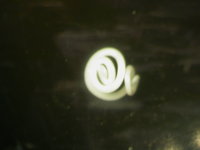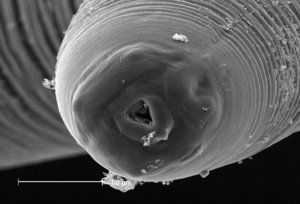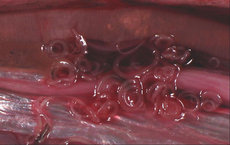Anisakiasis
Anisakis is a genus of parasitic nematodes, which have a life cycle involving fish and marine mammals. They are infective to humans and cause Anisakiasis, and fish which have been infected with Anisakis spp. can produce an anaphylactic reaction in people who have become sensitized to Immunoglobulin E. more...
Life cycle
Anisakis spp. have a complex life cycle which passes through a number of hosts through the course of its life. Eggs hatch in sea water and larvae are eaten by crustaceans, usually Euphausids. The infected crustacean is eaten by a fish or squid. The nematode burrows into the wall of the gut and encysts in a protective coat, usually on the outside of the visceral organs, but occasionally in the muscle or beneath the skin. The life cycle is completed when an infected fish is eaten by a marine mammal, such as a whale or dolphin. The nematode excysts in the intestine, feeds, grows, mates and releases eggs into the sea water in the hosts feces. As the gut of a marine mammal is functionally very similar to that of a human, Anisakis spp. are able to infect humans who eat raw or undercooked fish. The diversity of the genus has increased greatly over the past 20 years, with the advent of modern genetic techniques in species identification. It has been discovered that each final host species is home to its own biochemically and genetically identifiable sibling species of Anisakisspp., which is reproductively isolated. This finding has allowed the proportion of different sibling species in a fish to be used as an indicator of population identity in fish stocks.
Morphology
Anisakids share the common features of all nematodes; the vermiform body plan, round in cross section and a lack of segmentation. The body cavity is reduced to a narrow pseudocoel. The mouth located anteriorly, and surrounded by projections used in feeding and sensation, with the anus slightly offset from the posterior. The epidermis secretes a layered cuticle that protects the body from digestive juices.
As with all parasites with a complex life cycle involving a number of hosts, details of the morphology vary depending on the host and stage of life cycle which it is in. In the stage which infects fish, Anisakis are found in a distinctive watch-spring coil shape. They are roughly 2 cm long when uncoiled. When in the final host, Anisakids are longer, thicker and more sturdy, to deal with the hazardous environment of a mammalian gut.
Health implications
Anisakids pose a risk to human health in two ways: through infection with worms from the eating of under-processed fish, and through allergic reactions to chemicals left by the worms in fish flesh.
Anisakiasis
Anisakiasis is the disease caused by infection with Anisakis worms. It is frequently reported in areas of the world where fish is consumed raw, lightly pickled or salted. The areas of highest prevalence are Scandinavia (from cod livers), Japan (after eating sushi and sashimi), the Netherlands (by eating infected fermented herrings (Maatjes)), and along the Pacific coast of South America (from eating ceviche). Heating to 60 °C, or freezing to below −20 °C is an effective method of killing Anisakis.
Read more at Wikipedia.org



